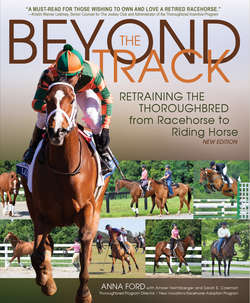Читать книгу Beyond the Track - Anna Morgan Ford - Страница 19
На сайте Литреса книга снята с продажи.
The Importance of Preparing for the Track
ОглавлениеLife at the track is fast-paced and busy. Without sufficient preparation for the change from early life on the farm to this new environment, the experience can be so stressful that some horses never transition. At New Vocations, we have only seen a few of these cases.
1.6 “Pony” horses are regularly used in training to help young Thoroughbreds gain confidence on the track.
It seems like common sense that a sufficiently trained and well-broken horse will have a better chance of racing successfully. Unfortunately, many owners do not know enough about racehorse training to realize that spending more money up front gives a horse a better chance of winning. While I have met many wonderful owners who make sure that their horses receive a solid foundation before going to the track, I have also met some who do not want or cannot afford to invest the time or money to get a Thoroughbred started well. For example, I have seen two-year-olds with only 30 days of training under saddle end up at the track. Often these horses end up being extremely nervous and develop bad habits that will persist after they retire from racing.
LIFE AT THE TRACK
1.7 A–J When working with an OTTB, it is important to consider the life he lived as a racehorse-in-training. The backstretch is a busy yet highly structured environment, which is why most OTTBs appreciate and thrive on a steady routine (A). On and around the track, there are rules for everything. Horses are walked to and from their workouts, some with a handler, while others can be ridden on a loose rein (B). Once on the track, jogging is limited to track space off the inside rail (C), as are slow steady gallops by single horses and the riders (D). Daily gallops are sometimes performed in pairs or small groups (E), while faster “workouts” usually involve two horses on the inside rail (F). After exercise, horses are bathed and hand-walked (G), and their legs wrapped for protection and support (H & I).
It is often hard to determine the actual experiences of an ex-racehorse, but when we receive an extremely nervous horse at New Vocations, chances are he was improperly and impatiently trained as a youngster. In such situations, our policy is to take him back to square one and begin again with work on the ground and in the round pen to give him a solid foundation before asking anything more demanding. (I discuss this process in detail beginning on p. 93.)
